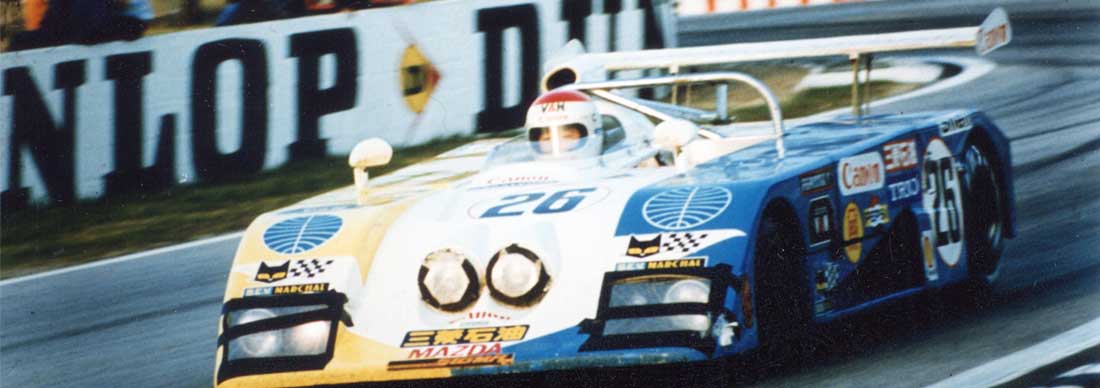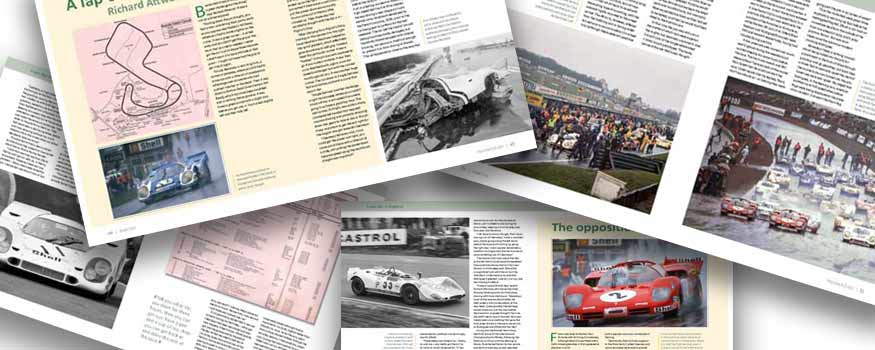
Première Night - part 2, by Serge Vanbockryck
Monocoques and wings
Defeated in 1952 by a lack of reliability, rather than Mercedes speed, Jaguar returned with a vengeance in 1953 and with the next big thing in auto racing: the three British Green C-types were now equipped with disc brakes, developed by Dunlop and tested earlier at the Mille Miglia. The Jaguars’ speed and reliability, combined with the new superior stopping power, secured a 1-2-victory for the Coventry make and sent drum brakes to the history books double quick. Confident about their technical prowess, the engineers at Jaguar prepared another novelty for the following year, when their new D-types were equipped with monocoque chassis. Like so many motorsports ‘inventions’, the monocoque had its roots in aviation when in 1912 Belgian engineer Armand Deperdussin coined the concept of a ‘skinless’ airplane. The airplane’s name, the SPAD Monocoque, also marked the first time the term was used.
Lancia later used a monocoque for its Lambda road car in 1922, but it was Jaguar who brought it to the race tracks, and successfully so. [Not forgetting that Alec Issigonis had designed his single-seater Lightweight Special with monocoque construction in the late ‘30s. Ed] and Duncan Hamilton and Tony Rolt came close to repeating the previous year’s success, but in the end lost by just 105 seconds to the Ferrari 375 of González and Trintignant.
After a computerised scoring system was introduced by IBM in 1958, the next technical innovation on the race cars was again presented by British engineers in 1963. The Owen Racing Organisation entered a car equipped with a 150bhp, 2.0-litre Rover turbine for Graham Hill and Richie Ginther. Since the car lacked a heat exchanger and also because it ran kerosene numbers way outside the fuel restrictions the ACO imposed, BRM-boss Alfred Owen had asked and received permission from the organisers to race his car outside of the official competition, hence the racing number 00.
For safety reasons, the Rover-BRM had had to start 30 seconds after the other competitors, but Hill and Ginther had an almost trouble free – and very silent – run which allowed them to cover 310 laps and which would have placed them in seventh overall. The Rover-BRM returned to Le Mans in 1965 in the shape of a now-legal coupe, driven by none other than Hill and Jackie Stewart, and finished in 10th overall. In 1968, the American Howmet Corporation entered a pair of turbine-driven cars with little success, and while more efforts were made to make the turbine work in IndyCar and in Formula 1 it never was a success.
Racecar engineering had been evolving at a faster pace since WW2 than before, and nowhere did this show better than at Le Mans, the race track with the longest straight in the world. The average race winning speed had rocketed from a mere 82.282mph in 1949 to 105.842mph by 1953, the year Jaguar had introduced the disc brakes. Another four years later, when Jaguar won the 1957 running, the average speed had already gone up to 113.846mph. By 1966, Bruce McLaren and Chris Amon won the race at an average of 130.979mph in their Ford Mk. II and a year later Dan Gurney and AJ Foyt did so in their Ford Mk. IV at 135.843mph, barely 4.3mph shy of the fastest ever race 43 years later. As much as sheer engine power and hardcore technical innovations had been instrumental in achieving these speeds, a considerable role had also been played by the actual shaping of the bodywork of the cars.
Aerodynamics was the new fashion word and with the increase of power came the concern of keeping those horses safely on the road. Likewise, those with fewer horses had been looking at ways of making better use of them. Rounder shapes, smaller frontal areas, relocated radiators, dive planes at the front and vertical fins at the rear of the cars showed the way the aerodynamicists were thinking, but few had been moving in the direction of Chaparral’s Jim Hall. With the CanAm race-winning Chevrolet-engined Chaparral 2E, Hall had not only introduced an even better aerodynamic body than on his previous cars, but also introduced the adjustable aerofoil, soon to be known as a ‘rear wing’. The device sat over the rear axle and by adjusting the inclination an amount of downward pressure could be achieved which helped the car stick to the road when, without the device, this would have been difficult at the same speed, like in rain or when going through corners.
While the Chaparral 2E had been an occasional race winner in the USA the year before, the new 2F model, entered in the entire 1967 WCM, arrived at Le Mans with exactly zero finishes on its scorecard. The new car had retired at Daytona, Sebring, Monza, Spa, the Targa Florio and the Nürburgring, each time for mechanical reasons. It didn’t lack speed, though, since the second fastest qualifying times at Daytona and Sebring were followed by three consecutive pole positions in Italy, Belgium and Germany. In France, too, the Chaparral started from the front row, but once again the net result for the pair of cars was two DNFs. Despite the poor results, the trend was set and the following year the works Porsche 908/8s all sported adjustable rear wings, though mounted at a more civilized height at the very rear of the car. In 1972, Henri Pescarolo and Graham Hill in their Matra-Simca MS670 scored the first overall win for a car equipped with a rear wing. Every winning car since has done so with one or more of the adjustable aerodynamic devices borrowed from the aerospace industry.
Rotary and turbos
In 1970 a pair of Belgians by the names of Yves Deprez and Julien Vernaeve decided to enter a Chevron B16 prototype with a 982ccm, type 10A, 200bhp, twin-rotor Mazda engine in the back. It was the first time a Japanese engine raced at Le Mans, and a wankel engine at that. German Felix Wankel – hence the name – had patented the concept for a piston-less engine in the late 1920s but it wasn’t until he worked for the NSU brand that he got a first prototype running some 30 years later. Apart from NSU, few manufacturers produced road-going cars with wankel engines, but Mazda would become the concept’s staunchest defender. The Belgians’ 1970 race didn’t last long, but their choice of powerplant had served as a wakeup call in the Land of the Rising Sun.

Above: (1973 Sigma-Mazda): The Mazda rotary engine made its debut in the back of a Chevron in 1970, but in 1973 the Japanese Sigma team entered the first Japanese car and Japanese drivers.
In 1973, the Japanese Sigma Automotive team ticked another few ‘first’ boxes for Japan. With its home-built, Mazda-equipped Sigma MC73 (this time a 250bhp type 12A twin-rotor) driven by Tetsu Ikuzawa and Hiroshi Fushida, Le Mans witnessed the arrival of the first Japanese team, car and drivers. Men and machine only made it to the halfway mark, but returned the following year to finish what they had started, even if they weren’t classified at the finish. Sigma turned to Toyota power for 1975 (another first for the team’s last appearance at Le Mans), but by then Mazda had taken the bait and started sending works teams to France from 1979 onwards, always running rotary engines. In 1991, Mazda became the first Japanese manufacturer to win Le Mans, with its trademark powerplant (by then a 700bhp, type R26B, quadri-rotor), the only ever win for a piston-less engine.

Above: (1980 Porsche 911 SC): Thierry Perrier’s Porsche 911SC ran on a 52/48 mixture of petrol and beetroot ethanol in 1980. The car qualified dead last, but 24 hours later did win its class.
In 1974 Porsche decided to give its serial class-winning Carrera the steroid treatment and enter it in the prototype class. The factory was not interested in fighting their many Carrera customers for GT class wins, and with new regulations coming up for 1976, the Stuttgart company figured it could already prepare for the future by taking the Carrera RSR to the next level. For that, the Porsche engineers decided to add an Abgas-Turbolader – or exhaust gas turbocharger. The principle of turbocharging to increase engine power had already been patented in 1905, and the idea was not new to auto racing either. A turbocharged diesel engine had been entered in the Indy 500 in 1952 and Porsche themselves had already used it to good effect on their CanAm 917/10s and 917/30s in 1972 and 1973. But now turbo power was to run down the Hunaudières Straight for the first time. With the 3-litre engine rule for prototypes, the Porsche engineers used a 2,142ccm flat-6 with a single KKK turbocharger, turbocharged engines needing to multiply their capacity by 1.4 to calculate the normally-aspirated equivalent.

Above & below: (1981 Ardex-BMW S80): French aerodynamicist Max Sardou entered this bizarre Ardex-BMW S80 with extreme ground effect venturi in 1981. Though Sardou had started the project back in 1974, the car arrived a day late at scrutineering because the paint wasn’t dry yet. It didn’t qualify for the race.

With some 500bhp on tap for just 830 kilos, the two silver Martini Porsches looked menacing, especially with their massive wheels, body extensions and huge rear wings. Porsche came close to beating the four-car works Matra squad for victory, especially when the leading car of Henri Pescarolo and Gérard Larrousse broke its gearbox at noon on Sunday while being chased by the Van Lennep/Müller Carrera RSR. Unfortunately for Porsche, the Matra’s gearbox was made by… Porsche, so they had to help out their customer, even if it meant reducing their own chances at winning the race. Forty-five minutes were lost, but Matra still won and Porsche finished second. The first turbocharged victory was a fact just two years later when Porsche won with its 936. Between 1976 and 2019, turbo engines would score another 35 victories at Le Mans, all bar five (Renault in 1978, Bentley in 2003, Peugeot in 2009 and Toyota in 2018 and ‘19) going to German manufacturers.

Above: (1981 Porsche 934 Turbo): In 1981 Thierry Perrier entered a Porsche running on alcohol for the second consecutive year, this time a 934 Turbo. Again he won the Group 4 category.
Première Night - part 3, by Serge Vanbockryck
Première Night - part 1, by Serge Vanbockryck
View books by Serge Vanbockryck






Leave a comment
This site is protected by hCaptcha and the hCaptcha Privacy Policy and Terms of Service apply.